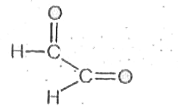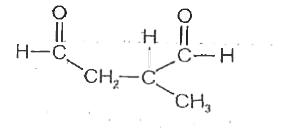Hexa-2,4-diene on ozonolysis by using O3/(C)Cl4 followed by Zn/H2O gives:
acetaldehyde
glyoxal
formaldehyde
propanaldehyde
The correct Answer is:A, B, D
Step by step video, text & image solution for Hexa-2,4-diene on ozonolysis by using O_(3)//(C)Cl_(4) followed by Zn//H_(2)O gives: by Chemistry experts to help you in doubts & scoring excellent marks in Class 12 exams.
Updated on:21/07/2023Topper's Solved these Questions
- UNSATURATED HYDROCARBONSBOOK - OP TANDONCHAPTER - UNSATURATED HYDROCARBONSEXERCISE - ASSERTION-REASON TYPES QUESTIONS
12 Videos
- UNSATURATED HYDROCARBONSBOOK - OP TANDONCHAPTER - UNSATURATED HYDROCARBONSEXERCISE - MATRIX MATCH TYPE QUESTIONS:
6 Videos
- UNSATURATED HYDROCARBONSBOOK - OP TANDONCHAPTER - UNSATURATED HYDROCARBONSEXERCISE - (LEVEL B) OBJECTIVE QUESTIONS
29 Videos
- STOICHIOMETRY (CHEMICAL FORMULAE AND EQUATIONS )BOOK - OP TANDONCHAPTER - STOICHIOMETRY (CHEMICAL FORMULAE AND EQUATIONS )EXERCISE - SELF ASSESSMENT
11 Videos
Similar Questions
An organic compound on reaction with O3 followed by Zn and H2Ogives CH3−O∣∣C−CH2−CH2−O∣∣C−CH3 . The structures are:
View Solutioni) An organic compound, C4H6, on ozonolysis gives formaldehyde and glycol. What is this compound?
ii) C4H6 can represent various structures, Identify:
a) Which reacts with ammoniacal AgNO3,
b) Which does not react with ammoniacal AgNO3 but by hot aklkaline KMnO4 gives CH3COOH,
c) Which decolourises Br2 water and by catalyst hydrogenation (using 1 mol) and subsequent reaction with alkaline KMnO4 gives CH3COOH and
d) Which by ozonolysis using O3/H2O gives succinic acid.
View Solution
Knowledge Check
Acetylene on ozonolysis with
(O3+Zn/H2O) givesAH−O∣∣C−O∣∣C−HBHO−O∣∣C−O∣∣C−OHCH2HO∣C−OH∣CH2DCH3−O∣∣C−HNatural rubber is a polymer of isoprene(2-methylbuta-1, 3-diene). If natural rubbber is treated with O3 followed by Zn/H2O, the final product will be
A BCH3−O∣∣C−CH2−CH2−CHOCCH3−CH2−O∣∣C−CH2−CHOD
BCH3−O∣∣C−CH2−CH2−CHOCCH3−CH2−O∣∣C−CH2−CHOD
An unknown compound on ozonolysis to give acid C3H6O2 and a ketone C4H8O. From this information identify structure of unknown compound.
A(CH3)2C=CHCH2−CH2CH3BCH3CH2−CH3∣C=CHCH2CH3C(CH3)2CHCH=CHCH2CH3DCH3CH2CH2CH=CHCH2CH2
An organic compound [A] C6H10, on reduction first gives [B] C6H12, and finally [C] C6H14. [A] on ozonolysis followed by hydrolysis gives two aldehydes [D] C2H4O, and [E] C2H2O. Oxidation of [B] with acidified KMnO4 gives acid [F] C4H8O2. Determine the structures of the compounds [A] to [F] with proper reasoning.
View SolutionAn organic compound [A] C6H10, on reduction first gives [B] C6H12, and finally [C] C6H14. [A] on ozonolysis followed by hydrolysis gives two aldehydes [D] C2H4O, and [E] C2H2O. Oxidation of [B] with acidified KMnO4 gives acid [F] C4H8O2. Determine the structures of the compounds [A] to [F] with proper reasoning.
View SolutionAn organic compound (A) reacts with H2 to give (B) and (C) suC Cessively. On ozonolysis of (A), tow aldehyes (D) C2H4O and (E) C2H2O2 and formed. On ozonolysis of (B) only propanal is formed. What are (A) to (E) ?
View SolutionAn unknown compound on ozonolysis to give acid C3H6O2 and a keton C4H8O . From this information identify structure of unknown compound
View SolutionAn organic compound (A) reacts with H2 to give (B) and ( C) successively. On ozonolysis of (A) , two aldehydes (D) C2H4O and ( E) C2H2O2 and On ozonolysis of (B) only propanal is formed. Compound (A), (D) & ( E) are
View Solution
